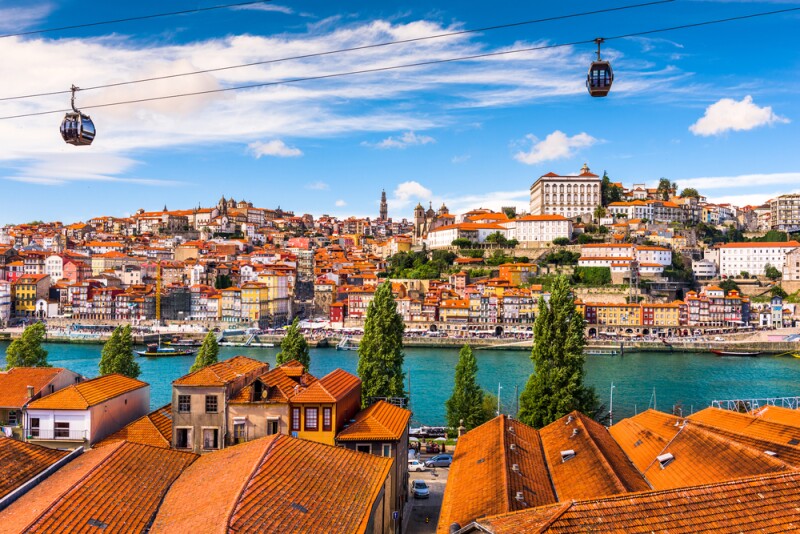Perched on the Atlantic on the edge of western Europe, Portugal offers a veritable feast for a traveler’s senses (especially when it comes to the taste buds). From sun-kissed coasts to cobblestone streets and fairy-tale castles, this small country is diverse in landscape and sightseeing offerings.
While Lisbon and Porto are usually featured in Portuguese travel itineraries, there’s much more to fall in love with here: seaside resort towns, mountain peaks, and verdant river valleys where time seems to stand still. Here are 10 not-to-be-missed places to visit on your next trip over the Atlantic.
1. Lisbon
Up to 30 years ago, this historic capital city was in varying states of disrepair, but today, thanks to a robust revitalization, this is one of Europe’s most charismatic and vibrant cities. Colorful azulejos (ceramic tiles) glisten in its sun-drenched streets as vintage trams rattle up hills. Spectacular sunsets over the city’s red-tiled roofs are cause for saudade—the Portuguese word for a feeling of yearning and nostalgia—which travelers will feel on their return home.
Lisbon is a walker’s delight, so meander through the cobblestone streets to its miradouros—lookout points to take in the city’s views—spread across its seven hills facing the Tagus River. Take the tram to Belém to marvel at Mosteiro dos Jerónimos, and reward your efforts with a delicious Pastéis de Belém, the original pastel de nata (egg custard tart).
Wander through the tangled alleyways of Alfama, where the traditional Portuguese music genre called fado was born. Stop into the Museu do Fado, and linger in the area for a sardine supper and Fado show at one of the many restaurants in this district.
Where to stay
- Book now: Tivoli Avenida Liberdade Lisboa
This five-star hotel on an ultra-posh street includes an outdoor pool surrounded by a tropical garden and a chic rooftop bar with city views.

The beauty of the Algarve lies in its heart-stopping seascapes.
Claudio Schwartz/Unsplash
2. The Algarve
At the southern end of Portugal, the Algarve region shines with a memorable coastline, golden-hued cliffs, and beaches filled with sea caves. The coastline of Ponta da Piedade in Lagos features sea pillars, rock arches, and grottoes in turquoise waters. It’s breathtaking and surreal. So is the Benagil cave—one of Portugal’s most famous attractions. Sunlight streams through its pierced ceiling, illuminating a gold-sand beach.
Where to stay
- Book now: Casa Modesta
Alongside the Ria Formosa lagoon, this rural nine-room boutique hotel offers serenity surrounded by nature.

Porto is Portugal’s second largest city.
Photo by ESB Professional/Shutterstock
3. Porto
Overlooking the Douro River, Porto is known for its stately bridges, port wine production, and dizzying viewpoints above terra-cotta rooftops. Once a trade village, Porto is now enjoying the fruits of ongoing development with cool cafés, wine bars, and new cultural offerings that reflect the city’s vibrant energy.
Popular sights include the medieval Ribeira district, a UNESCO World Heritage site, where tourists admire the atmosphere. Walk across the city’s iconic Ponte de Dom Luis I bridge to Vila Nova de Gaia to sip a glass of port, then catch a spectacular sunset at Jardim do Morro. Walk on the sea-facing promenade in Foz de Douro, admire the gilded interiors of the 15th-century São Francisco Church, and stop into the 2020-opened WOW (World of Wine), a sprawling complex of museums, restaurants, and bars near the river.
Where to stay
- Book now: The Yeatman
Wake up to incredible views of the city from this palatial hotel.

The Alto Douro region became World Heritage Site in 2001.
Photo by De Visu/Shutterstock
4. Douro Valley
For greener pastures, look to the rolling hills of the Douro Valley, one of the world’s oldest and best-known demarcated wine regions, dating back to 1756. Famed for its terraced vineyards, with vines ribbing the contours of steep granite slopes, this valley is the birthplace of port.
You can take a languid boat ride (six–seven hours) from Porto to get here, but the best way to experience the region is to rent a car and visit Quinta do Noval and other wine-growing estates, known as quintas. Most offer public tours with winetastings.
Where to stay
- Book now: Six Senses
A lavish 19th-century family home turned luxury resort, the Six Senses sits atop a hill, framed by terraced vineyards and the winding Douro River, near the baroque town of Lamego.

The lush Minho region borders Galicia, Spain.
Photo by AnaMarques/Shutterstock
5. The Minho
Portugal’s vinho verde hails from this verdant region of vineyard-covered valleys and towns frozen in time. Braga, one of Portugal’s oldest cities, has many baroque churches, and its old center brims with cafés, traditional Portuguese restaurants, and plazas.
A highlight of this region is Peneda-Gerês, one of the world’s few temperate rain forests, which borders Spain. You’ll need a car to head here, and while the curvy roads might make your stomach drop at times, the vistas are well worth the trek: The mountainous terrain with thick woods is punctuated by swift rivers, streams, and waterfalls. Canoe or hike, and meander through the region’s medieval castles or monasteries, which are well integrated into the landscape.
Where to stay
- Book now: Pousada Caniçada Gerês
In the heart of Peneda-Gerês National Park, this beautiful hotel overlooks the Cávado River. Order the bacalhau (cod) in its restaurant and enjoy the view.

The Moors ruled over Évora for more than 300 years.
Photo by Analisisgadgets/Shutterstock
6. Évora
A striking cathedral, cloisters, and the columns of the Templo Romano (near Roman baths) sit inside Évora’s 14th-century walls. Romans began inhabiting the city in the 2nd century B.C.E., and many ruins—including the Temple of Diana—remain, along with palaces and convents built by later occupants, including the Moors and Portuguese royalty. Évora was deemed a UNESCO World Heritage site in 1986, and the European Commission has designated it as 2027’s European capital of culture.
Tip: An experience travelers shouldn’t miss in this preserved medieval town is a soak in the serene Roman bath In Acqua Veritas.
Where to stay
- Book now: Octant Évora
Find sanctuary at this countryside getaway with four pools, set on 30 acres.

What kid wouldn’t love a real-life castle that is as colorful as Sintra just outside of Lisbon?
Shutterstock
7. Sintra
Portuguese royals used to spend their summers in Sintra, and it’s easy to see why. This UNESCO World Heritage site has storybook castles and fanciful gardens set in the hills, with imposing mansions and centuries-old monasteries rising from a backdrop of dense forests. The iconic former royal residence, Pena Palace, particularly stands out with its vivid red-and-yellow facade. Monserrate Palace is likewise grand and, like its gardens, is steeped in romanticism.
Where to stay
- Book now: Tivoli Palácio de Seteais
Originally the 18th-century residence of the Dutch consul, this neoclassical building with frescoed rooms opened as a hotel in 1955.

Coimbra served as Portugal’s capital from 1139 until 1260.
Photo by saiko3p/Shutterstock
8. Coimbra
Coimbra, on the banks of the Mondego River, was once Portugal’s capital and has an Old Town that dates back to Moorish times. It’s also a vibrant university town, with one of Europe’s oldest schools, the University of Coimbra, classified as a UNESCO World Heritage site. Built on the grounds of a former palace, the university is famed for its baroque library, the Biblioteca Joanina, and 18th-century bell tower. Take time to enjoy the lavish Botanical Garden of the University of Coimbra or the gardens of Quinta das Lágrimas.
Where to stay
- Book now: Sapientia Boutique Hotel
Sapientia Boutique Hotel, in central Coimbra, has a lovely rooftop terrace for watching sunsets over the city.

Once a strategic military point, Óbidos Castle now houses a hotel.
Photo by DaLiu/Shutterstock
9. Óbidos
As a gift to mark their wedding day in 1282, King Dinis gave this town to his queen, hence its nickname “The Town of Queens.” Stroll through the narrow streets of this small town, which is encircled by medieval walls and crowned by a Moorish castle. Travelers can find old whitewashed houses bordered with blue or yellow and historic churches worth visiting.
As a UNESCO Creative City, Óbidos hosts festivals, including the International Chocolate Festival, Óbidos International Literary Festival, and Christmas Town.
Where to stay
- Book now: Hotel Casa das Senhoras Rainhas
Located within the walls of Óbidos, this boutique hotel offers air-conditioned rooms with a balcony overlooking the castle walls.

Moliceiros were historically used to collect algae.
Photo by trabantos/Shutterstock
10. Aveiro
Hailed as the Portuguese equivalent to Venice because of its canals, maritime Aveiro is set along a lagoon called Ria de Aveiro. Brightly coloured moliceiros (traditional boats) float on its waters, and the city offers art nouveau buildings like the Cathedral of Aveiro and the Museu de Aveiro. Plus, Aveiro is known for a sweet made with eggs and sugar: Look for ovos moles (soft eggs) sold in wooden barrels or wrapped in a crisp wafer in different shapes.
Where to stay
- Book now: Hotel das Salinas
In the historical center of Aveiro, this hotel is great for exploring the city. The works of Portuguese artists and poets are woven into the decor.











